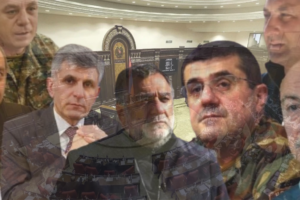In recent years, the Iranian regime has encountered numerous challenges, including economic downturn, societal unrest, and geopolitical tensions.
These factors have significantly influenced the regime’s priorities, resulting in the allocation of substantial resources to its security entities.
The aim of strengthening these entities is to uphold internal stability, counter perceived threats, and assert regional influence.
Over the past five years, a review of budgets reveals significant increases in various institutions. The budget of the Ministry of Information escalated from 5,825 billion tomans in 2018 to 7,291 billion tomans in 2019.
In 2020, the budget reached 7,765 billion tomans. Notably, in 2021-2022, the regime nearly doubled the budget for this security ministry, allotting 15,375 billion tomans.
In the current budget of 2023, the Ministry of Information’s budget has further increased to 22,599 billion tomans, reflecting a 2.8-fold growth compared to 2019.
Similar budget expansions have occurred in parallel intelligence institutions. The Intelligence Protection Organization of the Islamic Revolutionary Guard Corps (IRGC) witnessed its budget rise from 54.466 billion tomans to 59 billion tomans in 2019.
In 2021, the budget for this IRGC intelligence institution doubled to 130 billion tomans, followed by an allocation of 150 billion tomans in 2022 for information protection within the IRGC. In 2023, this institution’s budget amounts to 183 billion tomans, signifying a 2.3-fold increase compared to 2019.
In an unprecedented move, the regime has included budgetary provisions for its cybersecurity apparatus for the first time.
This allocation, totaling 847 billion tomans, reflects the regime’s focus on internet restriction and filtering, particularly within an environment known for its suppression of freedom of speech.
Additionally, a new budget clause, categorized under security and intelligence, designates 10,350 billion tomans for “maintaining order and public security.”
Within the same clause, 3 trillion tomans are allocated for the “policymaking and monitoring program for the establishment of public order and internal security and the holding of elections.”
The Basij organization, a significant paramilitary force under the regime, is granted a budget of 2,829 billion tomans for the current fiscal year.
Furthermore, special units of the police force receive 155 billion tomans, while the Tehran penitentiary is allotted 256 billion tomans.
The budget also includes provisions for constructing 59 new penitentiaries, with a budget of 3.5 billion tomans, as well as a temporary penitentiary with 1.4 billion tomans.
Examining the budgets of the regime’s religious propaganda departments over the last three years reveals noteworthy growth, indicating the regime’s intention to enhance its repression and influence in the Middle East and globally. A budget of 2,350 billion tomans is allocated for its propaganda institutions.
This year, the regime’s Headquarters for the Promotion of Virtue and the Prevention of Vice receives a budget equivalent to 126 billion tomans. Additionally, 1.57 billion tomans are designated for the repair of its equipment.
The ‘Rahian-e Noor’ state propaganda pilgrimage project is allocated 41.6 billion tomans, while the advertising office of the Qom seminary receives 414.2 billion tomans.
The Supreme Council of Seminaries receives 4,755 billion tomans, and the Policy Council of Sisters Seminary is allotted a budget of 1.20 billion tomans, indicating a significant growth compared to previous years.
Comparing these figures with other budgets, such as the 300 billion tomans for milk distribution in schools or the 40 billion tomans for the development of schools for nomadic tribes, demonstrates the regime’s differing priorities and policy choices.
The Islamic Propaganda Organization is assigned a budget of 3,354 billion tomans, while the Policy Council of Friday Prayers Imams receives 174 billion tomans. In contrast, the budget for the National Organization for Talents stands at around 141.7 billion tomans.
These budgetary allocations are sourced from the country’s resources, where the budget for sports and recreation, serving Iran’s population of 87 million, amounts to 22,315 billion tomans. The budget for culture and art is 25,440 billion tomans, and public education receives 22,495 billion tomans.
A peculiar budget is allocated to the so-called Al-Mustafa Al-Alamiya University, a regime propaganda institution, which is set to receive 1,170 billion tomans.
Additionally, approximately 122 billion tomans are provided as assistance to the fund of this institution, bringing the total expenditure to 1,122 billion tomans this year.
Last year, the university received 485 billion tomans, along with an additional 200 billion tomans subsidies. Al-Mustafa Al-Alamiya University, formed in 2007 through the merger of the ‘Organization of Schools and Seminaries Abroad’ and the ‘World Center of Islamic Sciences,’ operates under the supreme leader Ali Khamenei’s directives.
It has branches in 60 countries, aiming to identify individuals suitable for teaching Islam and providing them with training in Qom.
Imam Sadiq University, another university whose graduates directly enter government executive positions, has been receiving funding from the country’s general budget despite being categorized as a non-governmental institution. This year, the university is slated to receive approximately 179.7 billion tomans from public funds.
These various budget allocations highlight the regime’s emphasis on security, intelligence, religious propaganda, and ideological influence both domestically and internationally.
Source: Iran News Update





